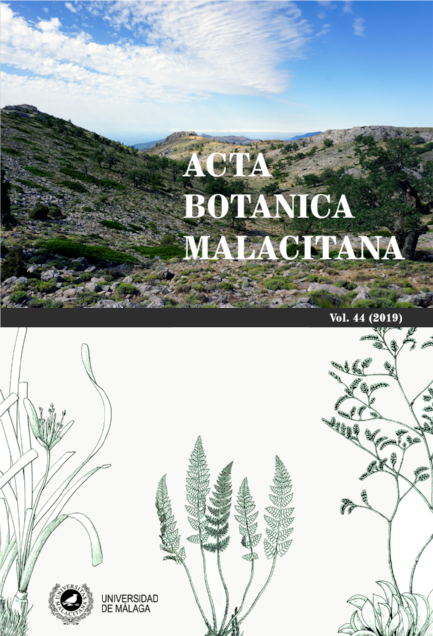Glyceria spicata subsp. onubensis (Gramineae), nuevo taxón para la flora ibérica
DOI:
https://doi.org/10.24310/abm.v44i0.6803Abstract
Glyceria spicata subsp. onubensis (Gramineae), new taxon for the iberian flora
Palabras claves: Glyceria, Gramineae, Península Ibérica, Taxonomía.
Key words: Glyceria, Gramineae, Iberian Peninsula, Taxonomy.
Downloads
Metrics
References
Borril, M. (1956). A biosystematic study of some Glyceria species in Britain. 2. Cytology. Watsonia, 3(6), 299–306.
Bushman, B.S., Sedegui, M. & Osterbauer, N.K. (2009). Distinguishing Glyceria species of Western North America. Seed Technology, 31(1), 66–75.
Church, G.L. (1949). A cytotaxonomic study of Glyceria and Puccinellia. American Journal of Botany, 36(2), 155–165.
Coutinho, A.X.P. (1939). Flora de Portugal, 2ª edição (p. 105). Lisboa: Irmãos Bertrand, Lda.
Franco, J.A. & Rocha-Afonso, M.L. (1998). Nova Flora de Portugal III Graminae, fasc. II (p. 72). Lisboa: Escolar Editora.
Gerlach, J.D., Bushman, B.S., McKay, J.K. & Meimberg, H. (2009). Taxonomic confusion permits the unchecked invasion of vernal pools in California by low mannagrass (Glyceria declinata). Invasive Plant Science and Management, 2, 92–97.
Gussone, J. (1844). Florae Siculae Synopsis (p. 784). Napoli: Ex Typis Tramater.
Kellogg, E.A. (2015). Flowering plants. Monocots: Poaceae. In K. Kubitzki (Ed.), The Families and Genera of Vascular Plants, 13. Cham: Springer International Publishing.
Lambinon, J. & Deschâtres, R. (1991) Glyceria notata Chevall. (= Glyceria plicata (Fries) Fries). In D. Jeanmonod & H.M. Burdet (Eds.), Notes et contributions à la flore de Corse, VII. Candollea, 46(1), 175–226.
Molina, J.A. & Pertiñez, C. (1997). Aspectos fitogeográficos del género Glyceria R. BR. (Poaceae) en la Península Ibérica. Studia Botanica, 16, 59–81.
Rodionov, A.V., Kotsinyan, A.R., Gnutikov, A.A., Dobroradova, M.A. & Machs, E.M. (2013). Variability of the ITS1-5.8S rDNA-ITS2 sequence during the divergence of sweet-grass species (Glyceria R. Br.). Russian Journal of Genetics: Applied Research, 3(2): 83–90.
Talavera, S. (1987). Glyceria R. Br. In B. Valdés et al. (Eds.), Flora Vascular de Andalucía Occidental 3 (pp. 357?359). Barcelona: Ketres Editora S.A.
Thiers, B. (2019) Index Herbariorum: A global directory of public herbaria and associated staff. New York Botanical Garden’s Virtual Herbarium. Available from: http://sweetgum.nybg.org/science/ih/ [consultado el 28-09-2019].
Tzvelev, N.N. (2006). Synopsis of the mannagrass genus, Glyceria (Poaceae). Botanischeskii Zhurnal (Moscow and Leningrad), 91(2), 255–276.
Valdés, B. & Scholz, H.; with contributions from E. von Raab-Straube & G. Parolly (2009). Poaceae (pro parte majore). Euro+Med Plantbase - the information resource for Euro-Mediterranean plant diversity. http://ww2.bgbm.org/EuroPlusMed/ [consultado el 28-09-2019].
Whipple, I.G., Barkworth, M.E. & Bushman, B.S. (2007). Molecular insights into the taxonomy of Glyceria (Poaceae: Meliceae) in North America. American Journal of Botany, 94(4), 551–557.
Downloads
Published
How to Cite
Issue
Section
License
All information related to the licensing of published works in Acta Botanica Malacitana and copyright can be found in our Editorial Policy.







1.png)
